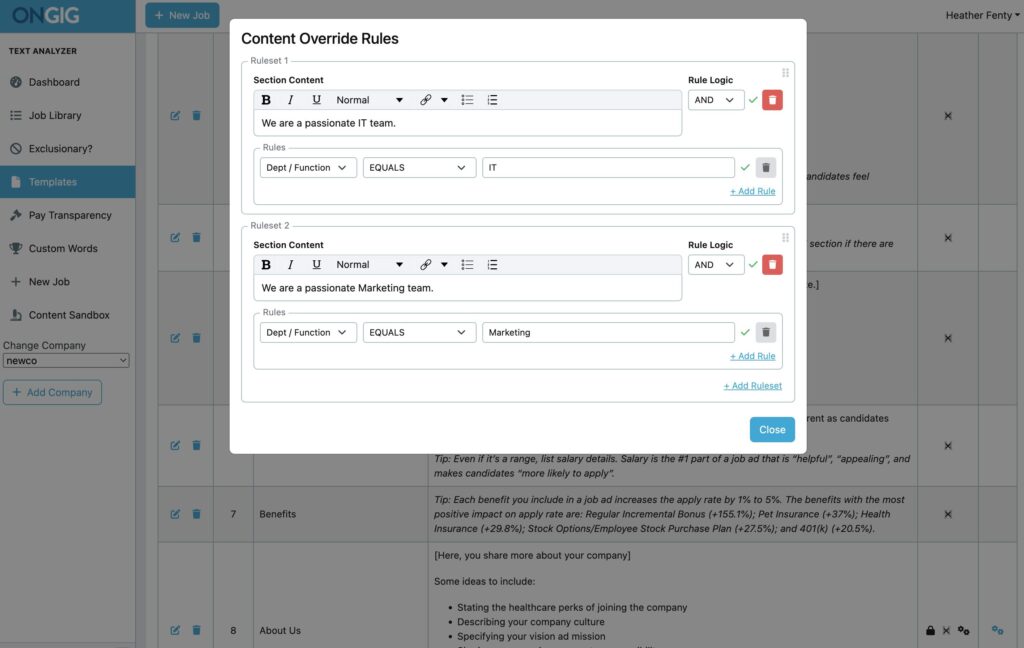- 16 Helpful Career Site Self-Service Tools for You - December 18, 2025
- Last Week I Had a Viral LinkedIn Post — But Why? (And What TA Folks Can Learn From It) - December 8, 2025
- Job Description Process Improvement: How One Workflow Fix Saved 1,200 JDs from Chaos - December 4, 2025
Have you ever seen a job post that felt like it was written by three different people? You probably have. That’s what happens when there’s no clear playbook for what should (and shouldn’t) go in a job description.
It’s also why so many TA teams ask us some version of this: “How should a job description be written?” The short answer? With structure. But not so much structure that you choke out the personality of the team that’s hiring.
Let’s talk about what to standardize and what to leave flexible, so your job postings are clear, compliant, and still human.
Standardize These 4 Core Sections in Every Job Posting
Most candidates skim job ads. And most want to answer these questions fast: What’s the job? Do I qualify? What’s it like to work here?
That’s why we recommend locking down the following:
- Job Summary: A quick snapshot (2-3 sentences) of what the role does and why it matters. Avoid buzzwords, keep it plain.
- Responsibilities: 5-7 bullet points. Action-oriented. Avoid overlap with qualifications (don’t say “must be able to write” in both).
- Qualifications: Separate required vs. preferred. Keep it short. If you list more than 5-7 bullets, people stop reading.
- How to Apply: A clear next step. Bonus points if you include what to expect after applying.
If you’re wondering what should be included in a job posting, start with those 4 sections. They’re the baseline of a solid job post. And they should look the same every time—same order, same headings, same style.
Make These Sections Flexible (with Rules)
Now, let’s talk about where you can give teams room to breathe. This is where “content override rules” come in handy.

At Ongig, we build smart templates that change specific blocks of content based on tags like department, location, or job level. Here’s where that really pays off:
- About the Team: Let’s say you’re hiring for both Engineering and Finance. One team might focus on innovation; the other on cross-functional collaboration. Different vibes. Different content. Same spot in the template.
- Culture or Perks: A job in Berlin may highlight different benefits than one in Boston. Our rules pull the right text for the right geography without creating extra templates.
- Legal Language: Some countries require specific compliance copy. We make sure that only appears when needed.
This means you keep the skeleton of your job description strong, but you give it muscle where it matters.
Real-World Example: From Chaos to Consistency
One global professional services firm we worked with had dozens of job posting templates floating around. Every department had its own version. And they were constantly editing the same roles over and over again—just to change one section.
So, we helped them implement a single job description template, powered by content override rules. They wanted flexibility for the “About the Team” section. Done. Now, when a role is tagged for Engineering, the system pulls in the approved Engineering team blurb. The same goes for Finance, HR, or any other group.
They went from juggling dozens of templates to managing one. And they saw results fast—fewer edits, faster launches, and better consistency across every region and department.
Why This Matters
When recruiters ask “what should be included in a job description” or “what should not be in a written job description,” they’re usually frustrated by the messiness. Posts get overwritten. Hiring managers paste in novel-length intros. Legal panics. Everything slows down.
With a smart template and a clear playbook, you take away the guessing. You get:
- Faster approvals
- Fewer edits
- Better candidate experience
- More consistent brand voice
And, importantly, you make room for the personality of each team to come through—without sacrificing structure.
Quick Checklist: What to Standardize vs. Customize
| Section | Standardize | Flexible (Use Rules) |
|---|---|---|
| Job Title | ✔ | |
| Summary | ✔ | |
| Responsibilities | ✔ | |
| Qualifications | ✔ | |
| About the Team | ✔ | |
| Culture/Perks | ✔ | |
| Compliance Language | ✔ (based on location) |
Why I Wrote This
Ongig helps TA teams clean up messy job descriptions with dynamic templates and smart rules. If you’re tired of the copy/paste chaos and want job posts that are consistent, clear, and still personal — Request a demo. We’ll show you how it works.
FAQs
What should a job description include?
It should include a summary, responsibilities, qualifications, culture info, and how to apply.
What are the 4 main sections you can expect to see in a typical job posting?
Summary, responsibilities, qualifications, and application instructions.
What should not be in a written job description?
Buzzwords, vague language, internal jargon, and unmeasurable traits.
Can I use one job posting template for all teams?
Yes—with smart rules to flex certain sections like “About the Team” or compliance copy.
How do I make sure job postings stay compliant?
Standardize key sections and use automated rules to insert region-specific legal language.
